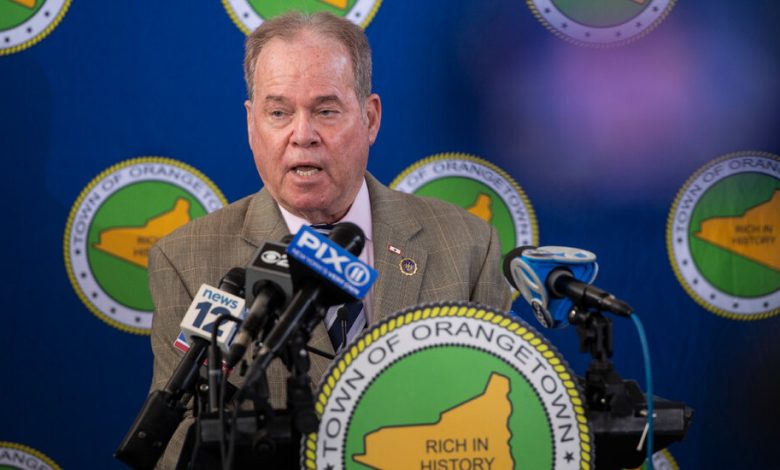The Suburbs Don’t Love New York

Good morning. We’ll look at why New York City and the surrounding suburban jurisdictions are increasingly at odds. We’ll also follow up on the story of the famous wine store that is accused of failing to deliver more than $1 million in orders to customers.

Ed Day, the chief executive of Rockland County, is one of the suburban officials who has fought against housing migrants in his county.Credit…Gregg Vigliotti for The New York Times
Tensions between the city and its surrounding areas over issues like crime, immigration and congestion pricing have grown since the pandemic. My colleague Jesse McKinley writes that there’s nothing new about the friction: Ever since Long Island highways and Hudson River crossings connected the city to its surrounding counties nearly a century ago, the different sides have fought over school funding, taxes, tolls, tunnels and bridges.
But recent moves by the city to solve its pressing problems have put it in direct conflict with suburban officials and their constituents. I asked Jesse to explain what is happening to the relationship between the city and the surrounding communities.
It used to be that the suburbs depended on the city — on people who lived in the suburbs but made their money working in the city. But one Long Island legislator told you that constituents tell him over and over again: “We don’t want to be New York City.” What do people mean when they say that?
It’s a combination of confluence of two trends. The city, long the political, cultural and social lodestar of the region, is suffering from an array of challenges, including crime and the economy, while the suburbs have been attracting newcomers and increasing both their diversity and their offerings, from food and drink to arts and entertainment. (The suburbs, of course, are not exempted from crime, and deal with their own challenges, including property taxes that often provoke groans from their residents.)
That perceived decline in the city’s luster may be a side effect of the pandemic, when boarded-up storefronts and a darkened Broadway were major emotional downers and when work-from-home made commuting less of a necessity. The city’s streets are back to bustling with resurgent tourism — some 60 million visitors are expected this year — but some suburbanites have gotten very comfortable working from their kitchens, patios and couches.
Add in the current costs of New York City, and you’ve got a situation where the city looks less and less appealing to some who live just outside it. Carlos Maldonado, a digital marketer who lives in Secaucus, N.J., told us that the pandemic “really kind of lifted the veil” on the allure of the city. “It’s like the fluff is gone now,” he said. New York City residents don’t see it that way. “You’re going to have to dog me pretty hard to convince me that New York City’s dead, that it has lost its shimmer,” Ashley Alpin, who has lived in the city for six years, told us.
How has the migrant crisis raised tensions between the city and the suburbs? One of the people you talked to is the county executive in Rockland County.
Not many issues unite Republicans and Democrats right now, but Mayor Adams’s plan to send thousands of migrants to motels and hotels in suburban communities has drawn condemnation from both sides of the aisle.
The plan has been criticized for a number of reasons, but a large part of the anger stems from the seeming lack of communication between officials in the city (as well as state leaders) and the counties that surround the city, some of which have used executive orders or legal action to try to stop migrants from being dropped in their communities.
Many county executives I spoke to expressed sympathy for the migrants’ plight, but furor at the city’s methods. Stephen Acquario, the executive director of the New York State Association of Counties, referred to the city’s “self-inflicted wound” when talking about how the Adams administration had handled things.
“And the wound is getting deeper and wider,” he said.
But the migrant crisis isn’t the only issue that has pulled the city and the suburbs apart. How did crime in the city during the pandemic, or the perception of crime, affect the political calculus in the suburbs? And how strong is the fear of crime?
The Republicans ran — and won — on crime and public safety in a series of races last year, including several in suburban districts. The result was four flipped congressional seats in otherwise deep-blue New York, something some national Democratic leaders said clearly figured in losing control of the House of Representatives.
While most crime statistics have improved, the perception of the city as a dangerous place — particularly its streets and subways — has been amplified by right-wing media and a series of high-profile cases, including the chokehold killing of Jordan Neely. Those stories have seemingly penetrated the minds of suburbanites.
City Councilwoman Nantasha Williams, a Democrat from Queens, said that some of the anti-New York City feeling “might be racially and politically charged.” How widespread is that feeling?
Many city lawmakers have suggested, both sotto voce and in louder terms, that the suburban opposition to the migrants stems from an ugly racial place. Suburban officials reject this notion, often pointing to their own immigrant roots. “We are not anti-immigrant,” said Kevin McCaffrey, the presiding officer of the Suffolk County Legislature, who recommended hiring legal counsel to try to prevent migrants from being resettled in the county. “If I was in that situation, I’d pack up my belongings and I’d have my kids on my back as well. But the fact of the matter is that we need to have laws.”
There’s already something of a border war between the city and New Jersey over congestion pricing. What’s behind the enmity?
One thing: cars.
Suburbanites need them; city dwellers don’t. And suburbanites — already facing high tolls on bridges and garages or parking lots that charge ransomlike rates — feel that it’s unfair that they could be dinged yet again for driving into Midtown Manhattan.
A lot of this seems emotional, too, doesn’t it?
For sure. In talking to residents outside the city, there seems to be a real schism between the priorities — and thus the policies that find favor.
Outside an American Legion Hall in West Islip, N.Y., Billy Survilla — who has lived in Suffolk County for years — put it like this. “They’re trying to make the suburbs the city. If we wanted to live in the city, we’d live in the city. But we don’t.”
As he said that, several friends who were standing around nodded approval.
Weather
Enjoy a partly sunny day near the high 70s. The evening is mostly cloudy, with temps around 60.
ALTERNATE-SIDE PARKING
In effect until June 28 (Eid al-Adha).
The latest New York news
-
Ex-lawyer dies before sentencing: James Ray III, a former New York City police officer and lawyer who was awaiting sentencing for murdering his longtime girlfriend, died after being found unconscious in a New Jersey jail cell, according to Essex County officials.
-
Vegan landlord: New Yorkers are used to finding quirky situations when apartment hunting, but a ban on cooking meat and fish in the building might be a new one.
-
Community on Juneteenth: At a time when Black families have been leaving New York, the weekend’s Juneteenth Food Festival at the Weeksville Heritage Center in Brooklyn cultivated a sense of community.
Famed wine store faces a criminal investigation
A federal grand jury in Manhattan is scheduled to hear evidence about Sherry-Lehmann Wine & Spirits, the venerable wine purveyor whose customers and former employees have complained about missing wine.
My colleague James B. Stewart writes that the proceeding is part of a criminal investigation into Sherry-Lehmann, which he reported last month had failed to deliver more than $1 million of wine to customers who had paid in advance. He also quoted former Sherry-Lehmann employees who said they believed the company was improperly selling wine that belonged to clients from a storage facility called Wine Caves.
The investigation is focused, at least in part, on Sherry-Lehmann’s owners, Shyda Gilmer and Kris Green, according to former employees who said they had been questioned about their dealings with the two men. The former employees said witnesses have been asked to appear before a federal grand jury later this month.
The investigation is being conducted by agencies including the U.S. attorney’s office in Manhattan, the Postal Service and the Police Department. The F.B.I.’s art crime team is also involved. Some of the wines handled by Sherry-Lehmann — whose Park Avenue store has been closed for months — sold for thousands of dollars a bottle.
A spokesman for the U.S. attorney’s office declined to comment. Representatives of the other agencies did not immediately respond to requests for comment. Neither did Eric Andrus, a spokesman for Sherry-Lehmann, nor Gilmer and Green.
METROPOLITAN diary
At Katz’s
Dear Diary:
Overheard during at Katz’s recently:
Customer: “I’m a vegetarian.”
Waiter: “So what are you doing here?
— Mitchell Erlitz
Illustrated by Agnes Lee. Send submissions here and read more Metropolitan Diary here.
Glad we could get together here. See you tomorrow. — J.B.
P.S. Here’s today’s Mini Crossword and Spelling Bee. You can find all our puzzles here.
Melissa Guerrero and Ed Shanahan contributed to New York Today. You can reach the team at [email protected].
.



